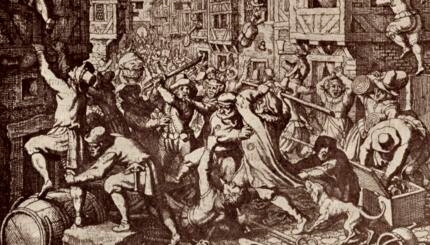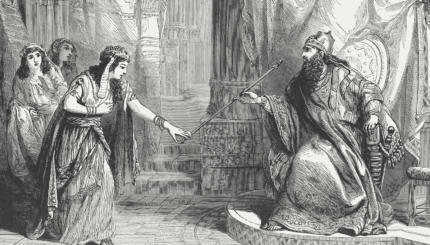Purim is a celebration of reversals. The Book of Esther, which is traditionally read twice on the holiday, states in Chapter 9 verse 1:
Now in the twelfth month, which is the month , on the thirteenth day of the same, when the king’s commandment and his decree drew near to be put in execution, in the day that the enemies of the Jews hoped to have rule over them; whereas it was turned to the contrary, that the Jews had rule over them that hated them.
This notion, of things being turned on their heads, called “venahafoch hu†in Hebrew, is at the core of this lively, raucous little holiday. The very purpose of our celebrating is intertwined with this overturning “from sorrow to gladness, and from mourning into a holiday†(Esther 9:22). As Rabbi Irving Greenberg puts it in his essay “Confronting Jewish Destiny: ,†in his book The Jewish Way: Living the Holidays:
Part of the dizzying paradox of Purim is the extraordinary and capricious reversals it reflects. Vashti is deposed as queen for showing modesty. Esther wins favor for the queenship because of her modesty…Mordecai, in one day, is raised from gallows candidate to prime minister. The very name of the holiday – Purim (meaning lottery) – suggests the absurdity and vulnerability of historical events when a turn of the wheel, a night’s insomnia, a moment of jealousy on the part of a drunken king, spells the difference between degradation and exaltation, between genocide and survival.
On Purim, we wear costumes, get drunk, and let go of the daily inhibitions – the cloak of order – that characterizes our lives, in order to acknowledge that our lives can change on a dime, and that a situation that looks devastating and grim can in fact become uplifting and celebratory.
But what is lurking beneath this notion of “venahafoch hu?†And what does it have to teach us, as a Jewish community, about our relationship to innovation and change, and those who turn, and sometimes overturn, the strictures of our community?
The Jewish Bible uses the term “hafach,†often translated as “turned,†in a number of different ways. Often, it is used to convey a reversal from one state to its opposite state, as in the case of the Megillah, or, as in Deuteronomy 33:6, “God turned the curse into a blessing for you.†It is also used to indicate any change, and not always necessarily as predictable as from a state to its opposite. Exodus tells of Moses’ staff, which turned into a snake (7:15) and of the water in the Nile river, which turned to blood (7:17), and the psalmist reminds us of God’s having turned the rock into a pool of water (Psalms 114:8).
The term is also used to convey destruction, as in Jonah’s warning to the people of Ninveh: “Another forty days and Ninveh shall be overturned†(Jonah 3:4). This is not only a change from one state to another, but a change from a state of order to a state of chaos, from civilization to destruction. And, finally, the term is used, simply, to convey movement. Lamentations refers to the heart that spins and turns within our midst (1:20), and Genesis describes the Garden of Eden as being guarded by the cherubim, holding a flaming sword “turning every which way†(3:24). This is not simply motion, but implies a spinning that is just barely in control, hovering at the edge of turmoil.
On Purim, then, we are not simply acknowledging that despair can turn to joyous exaltation. That is merely the tip of the Purim iceberg. The holiday, in fact, is intensely sobering. It reminds us that the world is spinning beyond our control, and, despite what we think, we cannot predict its direction, nor can we be certain that it won’t spin into a state of total destruction. This, perhaps, is why joy must be dictated during this month: mishenichnas Adar marbim be’simcha – when the month of Adar arrives we abound in joy (Talmud Megillah 29a) – because it is counter-intuitive to face the notion of “venahafoch hu†and to celebrate.
Perhaps this understanding of Purim can shed light on the Jewish community’s complex relationship to its innovators.
Our innovators keep us spinning. Paul Light, in his article “Social Entrepreneurship Revisited†in the Stanford Social Innovation Review, describes social entrepreneurship as “a wave of creative destruction that remakes society.†Innovators are involved in all levels of the “venahafoch hu†process, changing things from one state to another, sometimes to their opposite states, and keeping the world in motion, even sending it into turmoil. Jewish social entrepreneurs, as they spin and blow through the community, hover on the brink of overturning the Jewish world as we know it.
The field of Jewish innovation, like the holiday of Purim, may appear celebratory and joyous on its surface. It marks the possibility of renewal, which, in the Jewish community, ultimately means survival. But, like Purim, there are cold depths beneath this surface. There is something profoundly threatening about the field.
New Jewish ideas and institutions often, and sometimes by definition, threaten traditional modes of operating and thinking in the Jewish world. In creating something new, Jewish social entrepreneurs sometimes destroy the old. In painting a new portrait of our community, they sometimes eradicate the faces and images that have defined us over time.
This Purim, perhaps our challenge as a community is to approach this field of innovation, this realm of “venahafoch hu,†with the same simultaneously tremulous and unwavering joy we bring into the month of Adar. Light writes: “social entrepreneurs are driven by a persistent, almost unshakable optimism.†This attitude of hope in the face of potential adversity is a very Jewish notion, one of which we are reminded during the month of Adar.
When we face the spinning world, the possibility of unending turmoil and the potential destruction of all that we hold dear, we are reminded to approach it with joy and hope, with an eye towards redemption and possibility, with merry-making and feasting. With a celebration of our innovators, and the belief that, ultimately, when the book ends, we will have survived, flourished, thrived, and come out stronger for all the motion.
Maya Bernstein works as the Director of Education for UpStart Bay Area, which supports Jewish innovation in the Bay Area. She blogs regularly for Lilith Magazine and e-Jewishphilanthropy.com, where this essay is cross-posted.Â


